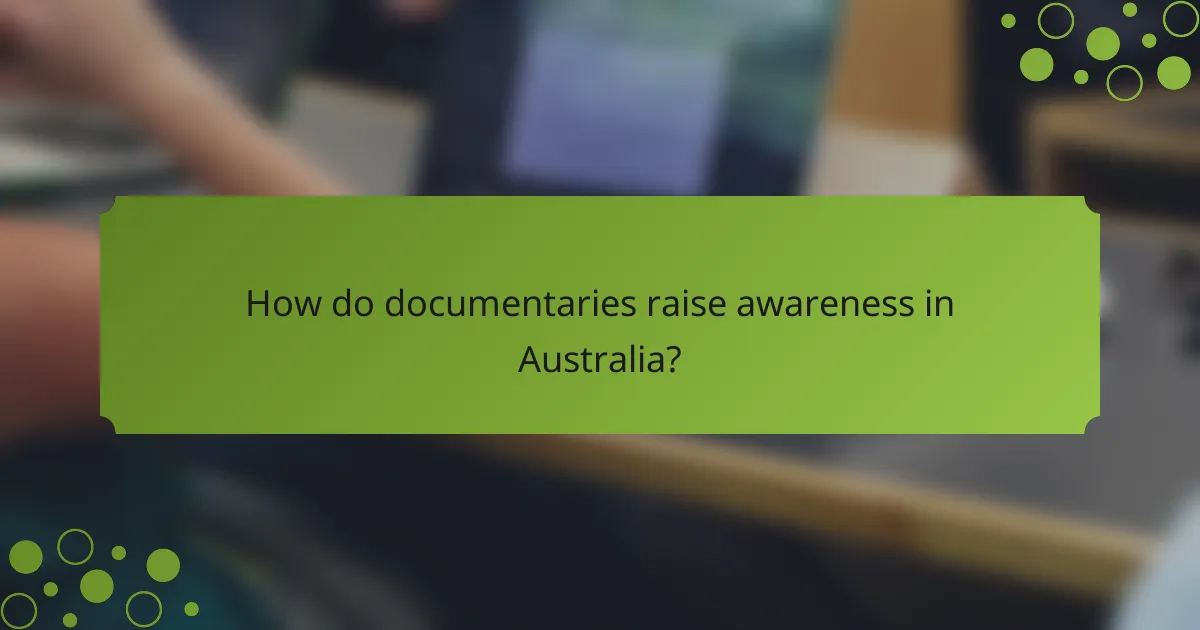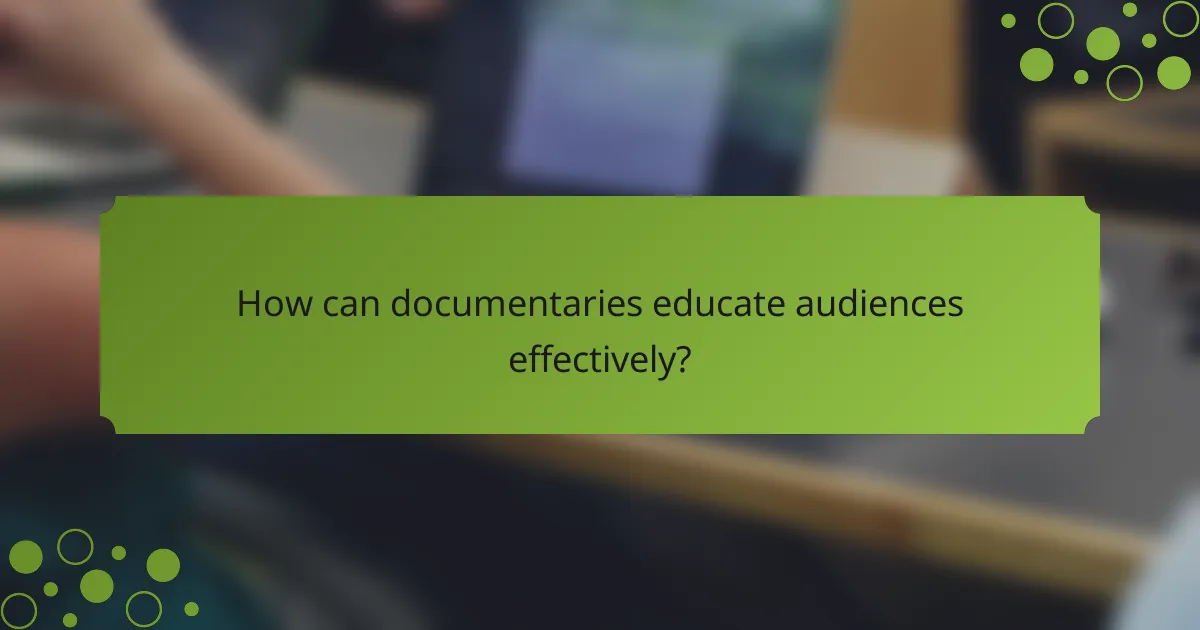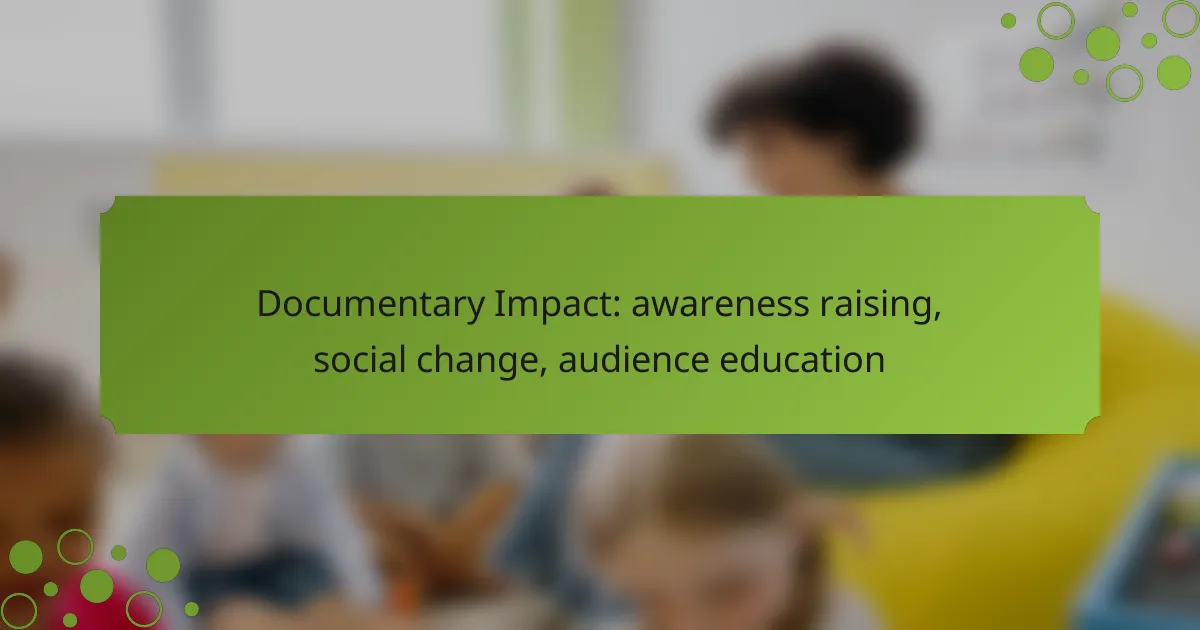Documentaries serve as powerful tools for raising awareness and driving social change by presenting compelling narratives that illuminate pressing social issues and cultural stories. By engaging audiences emotionally and intellectually, they inspire discussions and motivate action, ultimately shifting public perception and fostering grassroots movements. Through a blend of storytelling and factual information, documentaries educate viewers, encouraging critical thinking and reflection on important topics.

How do documentaries raise awareness in Australia?
Documentaries in Australia raise awareness by presenting compelling narratives that highlight social issues, cultural stories, and environmental concerns. They engage audiences emotionally and intellectually, prompting discussions and inspiring action on various topics.
Case studies of successful Australian documentaries
Several Australian documentaries have made significant impacts, such as “The Australian Dream,” which addresses racism in sports through the story of AFL player Adam Goodes. Another notable example is “Chasing Asylum,” which sheds light on the plight of asylum seekers in Australia, sparking public debate and policy discussions.
These films often lead to increased media coverage and community engagement, demonstrating how storytelling can influence public sentiment and drive social change.
Impact on public perception
Documentaries can shift public perception by framing issues in relatable ways, often leading to greater empathy and understanding. For instance, “2040” explores sustainable solutions to climate change, encouraging viewers to consider their own environmental impact.
As audiences connect with the stories and characters, they may become more inclined to support related causes or advocate for policy changes, illustrating the power of visual storytelling in shaping opinions.
Role of film festivals in awareness
Film festivals in Australia, such as the Sydney Film Festival and Melbourne International Film Festival, play a crucial role in promoting documentaries that raise awareness. These events provide a platform for filmmakers to showcase their work and engage with audiences through Q&A sessions and panel discussions.
By highlighting important social issues, festivals help to amplify the voices of underrepresented communities and encourage dialogue, making them vital in the documentary landscape for fostering awareness and change.

What social changes have been influenced by documentaries?
Documentaries have significantly influenced social change by raising awareness on critical issues and inspiring action among audiences. Through storytelling, they can shift public perception, motivate grassroots movements, and even lead to policy reforms.
Documentary-driven policy changes
Documentaries can catalyze policy changes by highlighting societal issues that require governmental attention. For instance, films focusing on climate change have prompted legislative discussions and initiatives aimed at environmental protection. These documentaries often serve as a wake-up call for policymakers, urging them to act on pressing issues.
To maximize impact, filmmakers should ensure their documentaries are well-researched and present clear, actionable solutions. Engaging with policymakers during the production can also enhance the likelihood of influencing legislative changes.
Grassroots movements inspired by films
Many grassroots movements have emerged as a direct result of documentaries that resonate with the public. These films often spotlight social injustices, prompting viewers to mobilize and advocate for change within their communities. For example, documentaries addressing racial inequality have inspired local organizations to form and push for reforms.
Filmmakers can support these movements by providing resources and platforms for activists to share their stories, thereby amplifying their message and fostering community engagement.
Examples of documentaries leading to social reform
Several documentaries have successfully led to social reform by raising awareness and inspiring action. “Blackfish,” which exposed the treatment of orcas in captivity, led to significant changes in public perception and policies regarding marine parks. Similarly, “The Act of Killing” brought attention to human rights abuses in Indonesia, influencing discussions around accountability and justice.
When creating impactful documentaries, filmmakers should focus on compelling narratives and emotional storytelling to connect with audiences. This approach can enhance the likelihood of sparking social reform and encouraging viewers to take action.

How can documentaries educate audiences effectively?
Documentaries educate audiences by presenting factual information in an engaging manner that encourages critical thinking and reflection. They combine storytelling, expert insights, and interactive elements to enhance understanding and promote social change.
Engaging storytelling techniques
Effective documentaries utilize compelling storytelling techniques to captivate audiences and convey important messages. By weaving narratives that resonate emotionally, filmmakers can create a connection between the viewer and the subject matter.
Techniques such as character development, conflict, and resolution help to illustrate complex issues in a relatable way. For example, following the journey of an individual affected by a social issue can humanize statistics and foster empathy.
Use of expert interviews
Incorporating expert interviews adds credibility and depth to documentaries. Experts provide context, analysis, and insights that help audiences understand the nuances of the topic being explored.
When selecting experts, consider their relevance and ability to communicate effectively. A mix of perspectives, including those from practitioners, academics, and affected individuals, can enrich the narrative and provide a well-rounded view of the issue.
Interactive elements in documentary courses
Integrating interactive elements into documentary courses can enhance audience engagement and learning. These elements may include discussion forums, quizzes, and hands-on projects that encourage active participation.
For instance, a course might include a project where participants create their own short documentary, applying the techniques learned. This practical approach not only reinforces educational content but also empowers individuals to express their perspectives on social issues.

What are the key criteria for impactful documentaries?
Impactful documentaries are characterized by their ability to engage audiences, raise awareness, and drive social change. Key criteria include authenticity, credibility, and a thorough understanding of the target audience.
Authenticity and credibility
Authenticity and credibility are essential for documentaries to resonate with viewers. Documentaries should present real stories, accurate information, and genuine voices to build trust and foster emotional connections. This can be achieved by using firsthand accounts, expert interviews, and verifiable data.
To enhance authenticity, filmmakers should avoid sensationalism and strive for a balanced portrayal of the subject matter. Engaging with the community being documented can also add depth and perspective, ensuring that the narrative reflects their experiences accurately.
Target audience analysis
Understanding the target audience is crucial for creating impactful documentaries. Filmmakers should analyze demographics, interests, and viewing habits to tailor content that resonates with specific groups. This can involve researching audience preferences and identifying the issues that matter most to them.
Effective audience analysis can lead to strategic choices in storytelling, style, and distribution. For instance, a documentary aimed at younger viewers may incorporate social media elements, while one targeting policymakers might focus on data-driven insights and expert opinions. Engaging the audience through interactive platforms can also enhance impact and encourage dialogue around the documentary’s themes.

How do online courses enhance documentary impact?
Online courses significantly enhance the impact of documentaries by providing filmmakers with essential skills and insights into storytelling, production, and audience engagement. These courses empower creators to effectively raise awareness, drive social change, and educate viewers through their work.
Course offerings from platforms like MasterClass
Platforms such as MasterClass offer a variety of courses tailored for aspiring documentary filmmakers. These courses often feature lessons from renowned industry experts, covering topics like narrative structure, cinematography, and ethical storytelling. For instance, a course on documentary filmmaking may include modules on researching subjects and crafting compelling narratives.
Additionally, many courses provide practical assignments, allowing students to apply what they’ve learned in real-world scenarios. This hands-on approach helps reinforce concepts and encourages creativity, making the learning experience more impactful.
Benefits of learning from industry professionals
Learning from industry professionals offers invaluable insights that can significantly enhance a filmmaker’s approach to documentaries. These experts share their experiences, including successes and challenges, which can inform students about best practices and common pitfalls in the field.
Moreover, industry professionals often provide feedback on student projects, helping them refine their work and develop a unique voice. This mentorship aspect can be crucial for emerging filmmakers looking to make a meaningful impact through their documentaries.

What are emerging trends in documentary filmmaking?
Emerging trends in documentary filmmaking focus on innovative storytelling techniques, the use of technology, and a growing emphasis on social impact. Filmmakers are increasingly leveraging digital platforms and interactive formats to engage audiences and drive social change.
Increased use of technology
Documentary filmmakers are adopting advanced technologies such as virtual reality (VR), augmented reality (AR), and 360-degree video to create immersive experiences. These tools allow viewers to engage with content in a more interactive manner, enhancing emotional connections to the subject matter.
For instance, VR documentaries can transport audiences to remote locations or significant historical events, making the experience more impactful. This trend encourages filmmakers to think creatively about how technology can enhance storytelling and audience engagement.
Focus on social issues
There is a notable shift towards addressing pressing social issues through documentary films. Filmmakers are using their platforms to raise awareness about topics such as climate change, social justice, and human rights. This trend reflects a desire to not only inform but also inspire action among viewers.
Documentaries like “13th” and “The Social Dilemma” have sparked conversations and movements, illustrating the potential for film to influence public opinion and policy. Filmmakers are encouraged to choose subjects that resonate with audiences and provoke thought and discussion.
Interactive and participatory formats
Interactive documentaries are gaining traction, allowing audiences to influence the narrative or explore content at their own pace. This format can include web-based documentaries where viewers can click through different storylines or contribute their own experiences.
Such participatory formats not only enhance viewer engagement but also democratize the storytelling process, giving a voice to diverse perspectives. Filmmakers should consider how to incorporate audience interaction to create a more personalized viewing experience.
